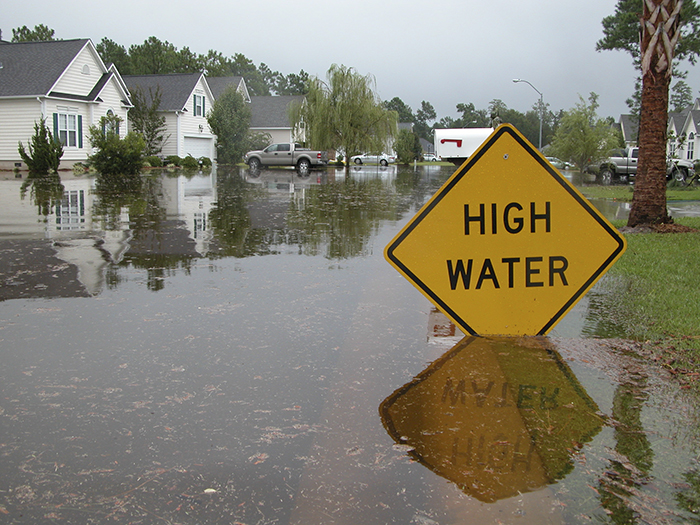Sponsored: Munich Re
How to Tackle the Growing Problem of Inland Flooding and Its Impact on Communities

Climate change has resulted in a host of extreme weather events. Warmer air tends to retain more moisture, which further increases the chances of a catastrophic flood event occurring and the resulting disruption. Naturally, the extensive damage caused to homes and businesses in coastal regions such as Florida battered by relentless hurricanes and flooding has grabbed most of the headlines because of the speed and severity at which it happens.
Yet, in truth, it is the inland regions, particularly those communities based along major rivers, that bear the brunt of most flood events.
The fact is that flood risk is everywhere: Between 1996 and the present day, almost 99% of all counties in the U.S. have been flooded, according to the Federal Emergency Management Agency (FEMA). Total losses from the Mississippi River flooding in 2019 amounted to more than $20 billion. It was the longest flood on record, surpassing even the 1927 Great Mississippi Flood. In many regions, whole communities and towns were under water for more than 200 days. Then, the COVID-19 pandemic struck, making it even harder for these communities to recover.
In California this year, economic losses have already topped $1 billion, with countless properties affected by the flash floods and mudslides that washed away Highway 1 out of Big Sur. The problem was exacerbated by the fact that the region experienced a dry winter followed by extreme precipitation across the state. This resulted in widespread flash flooding, erosion and mudslides.
Lack of Flood Coverage

James Doona, Managing Director, Munich Re Capital Markets
The even bigger problem, because many residents living in inland regions don’t perceive flood to be a significant risk, is that they don’t bother taking out flood insurance to protect their homes from a loss. This has created a vast coverage shortfall between the actual $20 billion economic losses and the insured losses of almost $200 million from the Mississippi floods, with only 4 to 5 percent of single-family homeowners having flood insurance out of 126 million homes.
“When people buy or rent a house, they don’t purchase flood insurance because they don’t think they will ever need it,” said James Doona, Managing Director of Munich Re Capital Markets. “It’s only when they actually experience a loss that it hits home.”
Those that have no coverage are left to rely on assistance from federal or state executive orders. The problem with the federal orders, however, is that, due to limited resources, often the funds are only distributed to those communities worst hit, while others affected miss out.
Because many inland communities don’t have flood coverage, if their home or business is caught in a flood, they are often left with nothing, because they can’t afford to repair the building or replace its contents. This makes it extremely difficult to recover from a loss and significantly reduces a community’s ability to withstand future events.
Even though many of these communities are eligible for FEMA and local grants and support, via the National Flood Insurance Program (NFIP), it is not nearly enough to cover the widespread devastation. For example, residents without flood insurance, on average, received around $10,000 per household after 2012’s Superstorm Sandy.
In contrast, those who had coverage got more than six times the amount — around $65,000. This gap was even higher for Hurricane Harvey, where the average claim was approximately $115,000. One of the reasons for this gap is that half of the FEMA flood maps are outdated. This creates a lack of understanding of the underlying risk for flood for the property owners.
Key Risk Mitigation Strategies

Raghuveer Vinukollu, Senior Vice President and Natural Catastrophe Solutions Lead, Munich Re US
There are several key steps homeowners and businesses can take to mitigate against the risk of flooding. One such solution could be adopting a community-based approach such as installing or upgrading infrastructure solutions like levees or dikes, and restoring nature-based solutions like wetlands.
Another way to mitigate the risk is by adopting stronger building codes. In a changing climate, cities and towns will need to incorporate and constantly update their building codes to ensure new (and existing) properties in flood zones are built above a certain height, based on past flooding events and future flooding risk.
“A one-size-fits-all solution does not work from a risk mitigation perspective,” said Raghuveer Vinukollu, Senior Vice President and Natural Catastrophe Solutions Lead at Munich Re US. “For example, a seawall, levee or dike might be the answer to protect against flooding in Northern California, whereas in another part of the state or country, the solution could be wetland restoration.”
But risk mitigation isn’t the solution alone; rather it needs to be complemented with the appropriate flood insurance coverage. The more people and businesses that have coverage, the more the risk can be spread among them.
A big part of achieving this is by educating communities about how risk mitigation and risk transfer can be used in concert.
“The vital factor is to educate communities about the potential impact of the risk on their property, particularly in the long run,” said Vinukollu. “As the climate warms, the flood risk of communities is bound to increase, in some cases significantly over time. To be resilient, property owners should be able to both mitigate their risk and have adequate financial instruments like insurance.”
By taking the appropriate mitigation action, policyholders can not only better protect their properties but also help to reduce premiums over time because the underlying risk is managed and lowered.
Munich Re US, in collaboration with the Nature Conservancy, has been exploring potential innovative risk transfer solutions that incorporate nature-based risk mitigation, e.g. levee setbacks. These solutions help in creating long-term sustainable insurance solutions for property owners in a changing climate.
The Role of Insurance
Insurance can play a vital role in helping businesses and individuals to recover more quickly after a catastrophic event. However, given the nature of flood as a risk, the cost of insurance must be addressed in the process. To make traditional coverage more affordable, exclusions and deductibles are often added to a policy. The problem arises when those areas that were excluded or had lower levels of coverage are hit with a flood loss.
Similar to risk mitigation, insurance can also be addressed at the community level. A recent white paper by Marsh McLennan and Wharton Risk Center presented a community-based catastrophe insurance (CBCI) product that can be developed to insure a group of properties within a community. The benefits of community insurance are multi-fold; it can help narrow the protection gap that exists for perils like flood by providing community-wide affordable solutions that not only incorporate the underlying risk but also the community-level mitigation.
Parametric insurance has emerged as a solution in recent years. Simpler than traditional insurance, policies are triggered if a pre-defined event is deemed to have happened because a set limit has been reached, making the payout process clear-cut and quick. It can also be tailored to the trigger point most likely to affect a property based on its specific situation, whether that be river depth or precipitation levels. Additionally, it can be used to cover expenses typically excluded from traditional policies, such as debris removal, high deductibles, economic losses caused by a reduction in business volume, or increased operating expenses and transportation costs.
Munich Re US has a comprehensive U.S. flood strategy and white-label flood insurance products that are designed to match communities, homeowners and businessowners with the right solutions to help them recover faster. When it comes to parametric covers, the company is well-versed in disaster risk management solutions, giving clients the support and protection they need to weather any storm.
“There is still a long way to go in terms of narrowing the protection gap and that’s where the insurance industry is constantly looking at providing new solutions, whether it’s from a community-based or a parametric approach,” said Vinukollu. “We’re already making big strides in that area, and we’ll continue to do so as climate change becomes even more of an issue for these communities.”
Education, collaboration and a willingness to invest in the future well-being of communities will drive Munich Re’s projects and others forward in helping to improve flood resiliency. This is a great example of public and private partners working together to solve unique problems with innovative, forward-thinking solutions.
To learn more visit https://www.munichre.com/us-non-life/en/solutions/reinsurance/products.html.
This article was produced by the R&I Brand Studio, a unit of the advertising department of Risk & Insurance, in collaboration with Munich Re. The editorial staff of Risk & Insurance had no role in its preparation.










